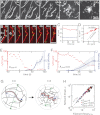F-actin buckling coordinates contractility and severing in a biomimetic actomyosin cortex
- PMID: 23213249
- PMCID: PMC3529094
- DOI: 10.1073/pnas.1214753109
F-actin buckling coordinates contractility and severing in a biomimetic actomyosin cortex
Abstract
Here we develop a minimal model of the cell actomyosin cortex by forming a quasi-2D cross-linked filamentous actin (F-actin) network adhered to a model cell membrane and contracted by myosin thick filaments. Myosin motors generate both compressive and tensile stresses on F-actin and consequently induce large bending fluctuations, which reduces their effective persistence length to <1 μm. Over a large range of conditions, we show the extent of network contraction corresponds exactly to the extent of individual F-actin shortening via buckling. This demonstrates an essential role of buckling in breaking the symmetry between tensile and compressive stresses to facilitate mesoscale network contraction of up to 80% strain. Portions of buckled F-actin with a radius of curvature ~300 nm are prone to severing and thus compressive stresses mechanically coordinate contractility with F-actin severing, the initial step of F-actin turnover. Finally, the F-actin curvature acquired by myosin-induced stresses can be further constrained by adhesion of the network to a membrane, accelerating filament severing but inhibiting the long-range transmission of the stresses necessary for network contractility. Thus, the extent of membrane adhesion can regulate the coupling between network contraction and F-actin severing. These data demonstrate the essential role of the nonlinear response of F-actin to compressive stresses in potentiating both myosin-mediated contractility and filament severing. This may serve as a general mechanism to mechanically coordinate contractility and cortical dynamics across diverse actomyosin assemblies in smooth muscle and nonmuscle cells.
Conflict of interest statement
The authors declare no conflict of interest.
Figures





Similar articles
-
Buckling-induced F-actin fragmentation modulates the contraction of active cytoskeletal networks.Soft Matter. 2017 May 3;13(17):3213-3220. doi: 10.1039/c6sm02703b. Soft Matter. 2017. PMID: 28398452 Free PMC article.
-
Thick filament length and isoform composition determine self-organized contractile units in actomyosin bundles.Biophys J. 2013 Feb 5;104(3):655-65. doi: 10.1016/j.bpj.2012.12.042. Biophys J. 2013. PMID: 23442916 Free PMC article.
-
Myosin-II activity generates a dynamic steady state with continuous actin turnover in a minimal actin cortex.J Cell Sci. 2018 Dec 11;132(4):jcs219899. doi: 10.1242/jcs.219899. J Cell Sci. 2018. PMID: 30538127
-
Interactions of airway smooth muscle cells with their tissue matrix: implications for contraction.Proc Am Thorac Soc. 2008 Jan 1;5(1):32-9. doi: 10.1513/pats.200704-048VS. Proc Am Thorac Soc. 2008. PMID: 18094082 Free PMC article. Review.
-
Principles of Actomyosin Regulation In Vivo.Trends Cell Biol. 2019 Feb;29(2):150-163. doi: 10.1016/j.tcb.2018.09.006. Epub 2018 Oct 29. Trends Cell Biol. 2019. PMID: 30385150 Review.
Cited by
-
Maximum limit to the number of myosin II motors participating in processive sliding of actin.Sci Rep. 2016 Aug 24;6:32043. doi: 10.1038/srep32043. Sci Rep. 2016. PMID: 27554800 Free PMC article.
-
Actomyosin Cortical Mechanical Properties in Nonadherent Cells Determined by Atomic Force Microscopy.Biophys J. 2016 Jun 7;110(11):2528-2539. doi: 10.1016/j.bpj.2016.04.034. Biophys J. 2016. PMID: 27276270 Free PMC article.
-
Side-binding proteins modulate actin filament dynamics.Elife. 2015 Feb 23;4:e04599. doi: 10.7554/eLife.04599. Elife. 2015. PMID: 25706231 Free PMC article.
-
Bioinspired Membrane Interfaces: Controlling Actomyosin Architecture and Contractility.ACS Appl Mater Interfaces. 2023 Mar 8;15(9):11586-11598. doi: 10.1021/acsami.3c00061. Epub 2023 Feb 27. ACS Appl Mater Interfaces. 2023. PMID: 36848241 Free PMC article.
-
Dynamic motions of molecular motors in the actin cytoskeleton.Cytoskeleton (Hoboken). 2019 Nov;76(11-12):517-531. doi: 10.1002/cm.21582. Epub 2019 Dec 9. Cytoskeleton (Hoboken). 2019. PMID: 31758841 Free PMC article.
References
-
- Bray D, White JG. Cortical flow in animal cells. Science. 1988;239(4842):883–888. - PubMed
-
- Guha M, Zhou M, Wang YL. Cortical actin turnover during cytokinesis requires myosin II. Curr Biol. 2005;15(8):732–736. - PubMed
-
- Medeiros NA, Burnette DT, Forscher P. Myosin II functions in actin-bundle turnover in neuronal growth cones. Nat Cell Biol. 2006;8(3):215–226. - PubMed
Publication types
MeSH terms
Substances
Grants and funding
LinkOut - more resources
Full Text Sources
Other Literature Sources

